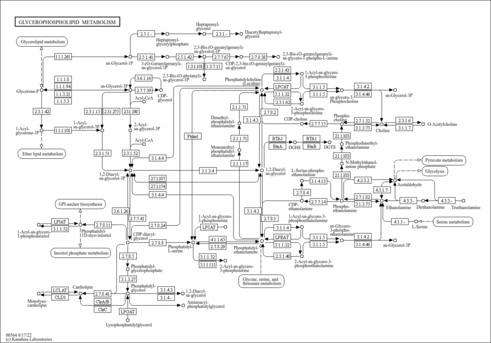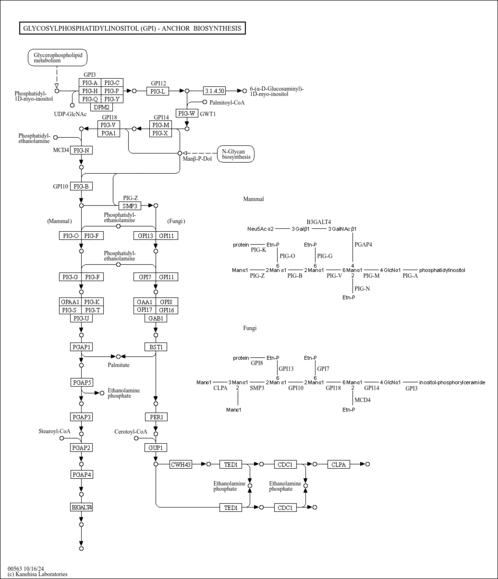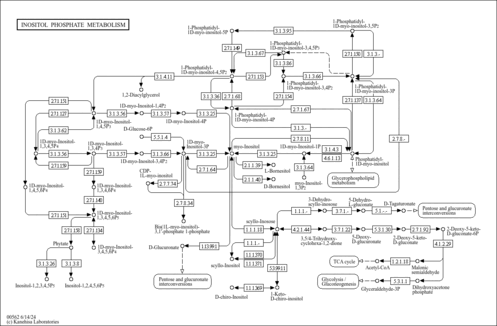| Identification |
|---|
| YMDB ID | YMDB00230 |
|---|
| Name | 1-Phosphatidyl-D-myo-inositol |
|---|
| Species | Saccharomyces cerevisiae |
|---|
| Strain | Baker's yeast |
|---|
| Description | Phosphatidylinositols are important lipids, both as a key membrane constituent and as a participant in essential metabolic processes, both directly and via a number of metabolites. Phosphatidylinositols are acidic (anionic) phospholipids that consist of a phosphatidic acid backbone, linked via the phosphate group to inositol (hexahydroxycyclohexane). Phosphatidylinositols can have many different combinations of fatty acids of varying lengths and saturation attached at the C-1 and C-2 positions. Fatty acids containing 18 and 20 carbons are the most common. In most organisms, the stereochemical form of the last is myo-D-inositol (with one axial hydroxyl in position 2 with the remainder equatorial. Phosphatidylinositol can be phosphorylated by a number of different kinases that place the phosphate moiety on positions 4 and 5 of the inositol ring, although position 3 can also be phosphorylated by a specific kinase. Seven different isomers are known, but the most important in both quantitative and biological terms are phosphatidylinositol 4-phosphate and phosphatidylinositol 4,5-bisphosphate. Phosphatidylinositol and the phosphatidylinositol phosphates are the main source of diacylglycerols that serve as signaling molecules, via the action of phospholipase C enzymes. While most phospholipids have a saturated fatty acid on C-1 and an unsaturated fatty acid on C-2 of the glycerol backbone, the fatty acid distribution at the C-1 and C-2 positions of glycerol within phospholipids is continually in flux, owing to phospholipid degradation and the continuous phospholipid remodeling that occurs while these molecules are in membranes. PIs contain almost exclusively stearic acid at carbon 1 and arachidonic acid at carbon 2. PIs composed exclusively of non-phosphorylated inositol exhibit a net charge of -1 at physiological pH. Molecules with phosphorylated inositol (such as PIP, PIP2, PIP3, etc.) are termed polyphosphoinositides. The polyphosphoinositides are important intracellular transducers of signals emanating from the plasma membrane. The synthesis of PI involves CDP-activated 1,2-diacylglycerol condensation with myo-inositol. |
|---|
| Structure | |
|---|
| Synonyms | - (3-Phosphatidyl)-1-D-inositol
- 1-Phosphatidyl-1D-myo-inositol
- 1-Phosphatidyl-myo-inositol
- 1,2-Diacyl-sn-glycero-3-phosphoinositol
- Phosphatidyl-1D-myo-inositol
- Phosphatidylinositol
- Phosphoinositides
- Inositol phospholipids
- Phosphatidylinositols
- Phospholipids, inositide
- PtdIns
- Inositide phospholipids
- Inositol, phosphatidyl
- Phosphoglycerides, inositol
- Phospholipids, inositol
- Inositol phosphoglycerides
- Phosphatidyl inositol
|
|---|
| CAS number | Not Available |
|---|
| Weight | Average: 390.2345
Monoisotopic: 390.056327206 |
|---|
| InChI Key | GUBXYMKIJFOYOA-WSRCIYAPSA-N |
|---|
| InChI | InChI=1S/C11H19O13P/c12-3-21-1-5(22-4-13)2-23-25(19,20)24-11-9(17)7(15)6(14)8(16)10(11)18/h3-11,14-18H,1-2H2,(H,19,20)/t5?,6?,7-,8?,9+,10-,11?/m0/s1 |
|---|
| IUPAC Name | [2,3-bis(formyloxy)propoxy]({[(2R,3S,6S)-2,3,4,5,6-pentahydroxycyclohexyl]oxy})phosphinic acid |
|---|
| Traditional IUPAC Name | 2,3-bis(formyloxy)propoxy[(2R,3S,6S)-2,3,4,5,6-pentahydroxycyclohexyl]oxyphosphinic acid |
|---|
| Chemical Formula | C11H19O13P |
|---|
| SMILES | [H]OC1([H])C([H])(O[H])[C@]([H])(O[H])C([H])(OP(=O)(O[H])OC([H])([H])C([H])(OC([H])=O)C([H])([H])OC([H])=O)[C@]([H])(O[H])[C@@]1([H])O[H] |
|---|
| Chemical Taxonomy |
|---|
| Description | belongs to the class of organic compounds known as phosphatidylinositols. These are glycerophosphoinositols where the glycerol is esterified with two fatty acids. |
|---|
| Kingdom | Organic compounds |
|---|
| Super Class | Lipids and lipid-like molecules |
|---|
| Class | Glycerophospholipids |
|---|
| Sub Class | Glycerophosphoinositols |
|---|
| Direct Parent | Phosphatidylinositols |
|---|
| Alternative Parents | |
|---|
| Substituents | - Diacylglycerophosphoinositol
- Inositol phosphate
- Cyclohexanol
- Dialkyl phosphate
- Cyclitol or derivatives
- Alkyl phosphate
- Dicarboxylic acid or derivatives
- Phosphoric acid ester
- Organic phosphoric acid derivative
- Cyclic alcohol
- Carboxylic acid ester
- Secondary alcohol
- Carboxylic acid derivative
- Polyol
- Hydrocarbon derivative
- Organic oxide
- Alcohol
- Carbonyl group
- Organic oxygen compound
- Organooxygen compound
- Aliphatic homomonocyclic compound
|
|---|
| Molecular Framework | Aliphatic homomonocyclic compounds |
|---|
| External Descriptors | Not Available |
|---|
| Physical Properties |
|---|
| State | Solid |
|---|
| Charge | 0 |
|---|
| Melting point | Not Available |
|---|
| Experimental Properties | | Property | Value | Reference |
|---|
| Water Solubility | Not Available | PhysProp | | LogP | Not Available | PhysProp |
|
|---|
| Predicted Properties | |
|---|
| Biological Properties |
|---|
| Cellular Locations | - cell envelope
- mitochondrion
- Golgi
- endoplasmic reticulum
- nucleus
- vacuole
- cytoplasm
|
|---|
| Organoleptic Properties | Not Available |
|---|
| SMPDB Pathways | |
|---|
| KEGG Pathways | | Glycerophospholipid metabolism | ec00564 |  | | Glycosylphosphatidylinositol(GPI)-anchor biosynthesis | ec00563 |  | | Inositol phosphate metabolism | ec00562 |  |
|
|---|
| SMPDB Reactions | |
|---|
| KEGG Reactions |
|
|---|
| Concentrations |
|---|
| Intracellular Concentrations | Not Available |
|---|
| Extracellular Concentrations | Not Available |
|---|
| Spectra |
|---|
| Spectra | |
|---|
| References |
|---|
| References: | - UniProt Consortium (2011). "Ongoing and future developments at the Universal Protein Resource." Nucleic Acids Res 39:D214-D219.21051339
- Foti, M., Audhya, A., Emr, S. D. (2001). "Sac1 lipid phosphatase and Stt4 phosphatidylinositol 4-kinase regulate a pool of phosphatidylinositol 4-phosphate that functions in the control of the actin cytoskeleton and vacuole morphology." Mol Biol Cell 12:2396-2411.11514624
- Han, G. S., Audhya, A., Markley, D. J., Emr, S. D., Carman, G. M. (2002). "The Saccharomyces cerevisiae LSB6 gene encodes phosphatidylinositol 4-kinase activity." J Biol Chem 277:47709-47718.12361950
- Taylor, G. S., Maehama, T., Dixon, J. E. (2000). "Myotubularin, a protein tyrosine phosphatase mutated in myotubular myopathy, dephosphorylates the lipid second messenger, phosphatidylinositol 3-phosphate." Proc Natl Acad Sci U S A 97:8910-8915.10900271
- Nikawa, J., Yamashita, S. (1997). "Phosphatidylinositol synthase from yeast." Biochim Biophys Acta 1348:173-178.9370330
- Strahl, T., Thorner, J. (2007). "Synthesis and function of membrane phosphoinositides in budding yeast, Saccharomyces cerevisiae." Biochim Biophys Acta 1771:353-404.17382260
- Guo, S., Stolz, L. E., Lemrow, S. M., York, J. D. (1999). "SAC1-like domains of yeast SAC1, INP52, and INP53 and of human synaptojanin encode polyphosphoinositide phosphatases." J Biol Chem 274:12990-12995.10224048
|
|---|
| Synthesis Reference: | Not Available |
|---|
| External Links: | |
|---|



